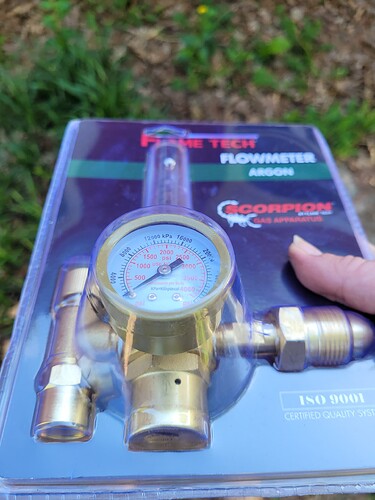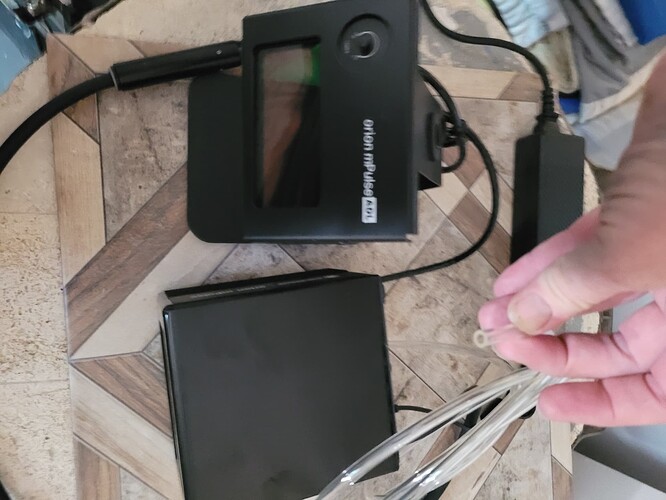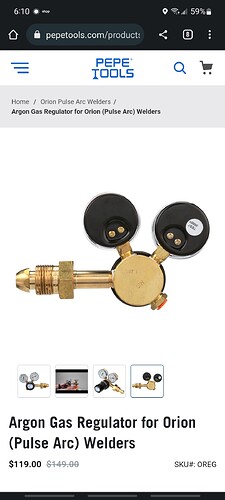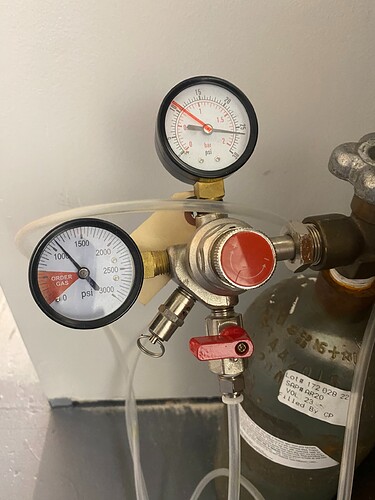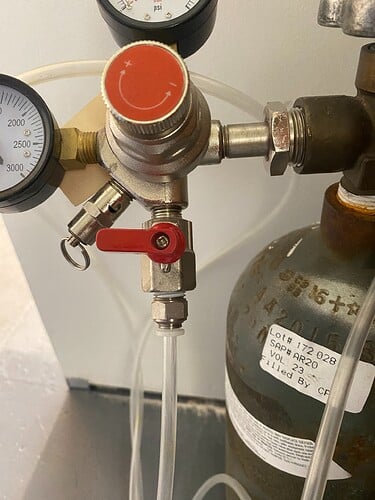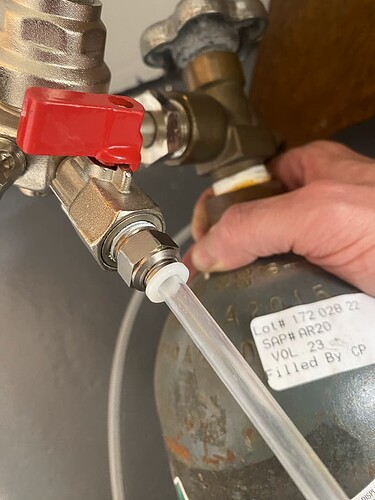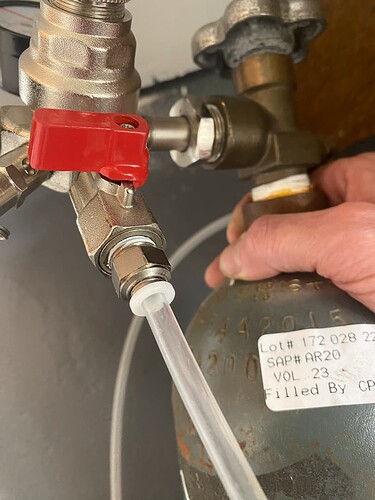I finally got my arc welder today and it looks like the regulator i bought cant be used and i need to buy the one at pepe. See the little orange thing in the end?
You should be able to get an adapter. That fitting isn’t necessarily integral to the regulator. This is how mine is setup on my Orion. Check your local welding supply place.
Thank you! I was looking at adaptors and was wondering if it had to have the orange. Is it male or female. I see your argon is inside, the guy at airgas scared me so bad i put mine outside.
The orange thing is a protective plug to make sure no contaminate enters during transport or handling.
When it is well attached to the bottle you remove it and open the vent to give it a couple of quick flushes, so anything inside will be blown out.
Make sure to close the main valve completely before you proceed.
Then you attach what ever you need for your hose and you are ready.
Hi,
i think the small orange thing is where you push in the hose…i forget the name…something like “quick connect”, where you just push the hose in, versus a barbed fitting the the hose fits over…?
julie
You might be right, the picture is not very good.
Though then there is a opening, and they are usually blue or black.
Apparently theres an adapter you have to buy they dont tell you about.
I’m interested in seeing if you can get this style argon regulator to work? Orion and PUK micro welders require a low-flow argon regulator to work effectively. It’s hard to tell from the picture, but it looks just like an argon regulator that a friend of mine bought which isn’t compatible with your new welder.
Years ago, Orion had some issues with their first generation of argon regulators and now sell an upgraded version. If you can’t get this regulator to work, it’s probably best to buy the Orion regulator designed for your welder. At least that’s my advice.
Hope that helps!
Jeff
Get a PUK regulator, they just hook up and work. I just changed out a tank of Argon that lasted over a year.
I actually like the one pepe sells w the unit better than this one, so debating getting the adapter or sending this one back.
In that phase years ago, when Orion argon regulators didn’t work as well as hoped, a lot of people bought PUK argon regulators to go with their Orion welders. Nothing wrong with that still, if that’s what you want to do. PUK regulators work really well. But one thing to remember is that PUK welders recommend a lower argon pressure than Orion recommends. The proper amount of argon for an Orion welder with a PUK regulator will move the regulator out of what PUK says is the ideal argon pressure range.
To measure the proper amount of argon for an Orion welder with a PUK regulator you have to go into the Orion welder’s internal gas settings and regulate the pressure from there. Once you do that, you’ll know the proper setting on a PUK regulator to work with an Orion.
Right now, I’ve got a PUK 5.1 and an Orion 200i3 with both company’s regulators. Sometimes for various reasons (like an argon tank running out) I mix regulators back and forth.
One other thing to remember is that PUK regulators only measure in Liters per Minute (LPM). Orion regulators measure in both LPM and PSI. (Pounds per Square Inch.) I’ll be honest, that confused me at first, but once I understood how the two measuring systems correlate, it was really easy to make it all work.
Jeff
LPM is flow and PSI is pressure.
It could have been LPM and Bar/Pascal for that matter.
I just looked at Orion’s website, Pepe’s website and Gesswein’s website. (Gesswein sells PUK’s) Pepe is selling the same Victor argon regulator as Orion does on their website, for $30ish less. $119 vs. $149. Gesswein is selling the PUK argon regulator for $292.50.
Totally up to you, but I think the choice is clear. I’d get the regulator designed for your welder from Pepe.
Jeff
The PUK regulator just sips argon. Argon is not explosive. Otherwise every time you generate a spark, the thing would blow up. It is a shielding gas.
This is quite a pile-on…I agree that argon is not something to get real worried about, as it is an inert gas that isn’t going to explode. Worst thing that’s going to happen is you are going to waste gas with a leak and spend money. As far as the little orange plug, I thought it was to keep dust out during shipping, too, but then I looked at the Pepe video and it looks like the plastic part is just the same as the brass reducer in the video which reduces the diameter of the output down to where the plastic tubing is just a press fit. So probably you can use that regulator, if the other one isn’t better in some way. -royohn
Mine is just a little quick-connect attached to the shut off. You push the hose into it.
Welding suppliers have to try and scare you. They don’t want to hand out liability so they tend to be protective. It can be annoying if you are a jeweler. If you aren’t wearing carhartts head to toe and steel toes you just don’t register as trustworthy.
It is an heavy gas so if there is a leak in an unventilated area it can displace the air/Oxygen.
Which in turn may be deadly, but no risk of explosion ![]()
Per-Ove,
I stand corrected…it is quite dangerous if you get asphyxiated! My question is how much argon at standard temperature and pressure is released if your cylinder lets go? I’d guess that it could fill a small room, but what happens if my cylinder lets go all of its contents into my 1800 square foot home, where the forced air heating system is blowing it around? Is it diluted enough to keep it from suffocating me? A low oxygen monitor costs about $100. I didn’t see one that would detect both argon and propane. -royjohn
I have yet heard of an accident releasing all in one go.
More likely is a slow leak and if there is ventilation and not to tight it should be safe enough.
Same issue with Carbon dioxide, they will both displace the air and is without color and smell.
I guess good procedures of holding the valve closed when not in use should be sufficient,
it is best for economy as well. ![]()
